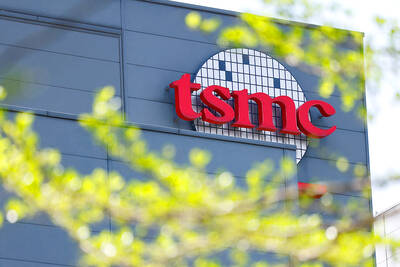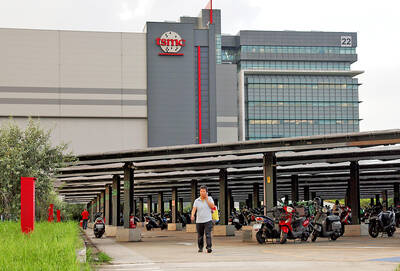Uber yesterday sold its Southeast Asian business to rival Grab, ending a bruising battle between the ride-hailing behemoths and marking the US firm’s latest retreat from international markets.
Singapore-based Grab is taking over the ride-sharing and food delivery operations of Uber in the region, with the California-headquartered company to receive a 27.5 percent stake in the business in return.
The sale is Uber’s latest withdrawal from a market where it had faced tough competition, as new chief executive Dara Khosrowshahi seeks to stem huge losses and move past a series of scandals.

Photo: AP
After a fierce battle, Uber sold its China operations to rival Didi Chuxing (滴滴出行) in 2016 in return for a stake, and last year the US firm merged in Russia with the taxi-hailing app of internet giant Yandex.
The deal with Grab — which operates in eight Southeast Asian countries — is similar to the one struck with Didi, and ends a fight for market share in a region that is home to about 650 million people and an increasingly affluent middle class.
“Today’s acquisition marks the beginning of a new era,” Grab chief executive Anthony Tan (陳炳耀) said. “The combined business is the leader in platform and cost efficiency in the region.”
“This deal is a testament to Uber’s exceptional growth across Southeast Asia over the last five years,” said Khosrowshahi, who is joining Grab’s board as part of the agreement. “It will help us double down on our plans for growth.”
The value of the deal, which Grab said was the largest ever acquisition by a Southeast Asian Internet firm, was not disclosed.
Grab has long been the dominant force in ride-hailing in Southeast Asia and speculation mounted that a deal with Uber was on the cards after Japanese financial titan Softbank invested huge sums in the US firm.
Softbank is also a major investor in Grab, and is known for pushing for consolidation in the global ride-hailing industry, which has been losing billions of dollars a year due to turf wars.
As part of the deal, Grab is combining Uber’s food delivery service in the region with its own and plans to expand it to more countries.
While both sides said the move would benefit customers, analysts raised concerns a lack of competition could push up prices.
“Industry consolidation will mean fewer choices for commuters and fares are likely to trend higher over time as the remaining players seek to improve their profitability longer term,” said Corrine Png, a transport analyst from Singapore-based research firm Crucial Perspective.
Grab, launched in 2012, has poured money into expanding its regional fleet and now operates in 195 cities in Singapore, Indonesia, the Philippines, Malaysia, Thailand, Vietnam, Myanmar and Cambodia.
As well as linking customers up with private cars, it has services offering motorbike taxis in some countries, regular taxis and carpooling, as well as food and package delivery.
Before the acquisition, Uber operated in 64 cities in eight Southeast Asian countries.
Competition between ride-hailing apps has been heating up in Southeast Asia, with the market forecast to grow more than five times to US$13.1 billion by 2025, according to a 2016 report by Singapore sovereign wealth fund Temasek.
Uber is the largest firm of its kind with a presence in more than 600 cities, but it has been rocked by scandals and is facing fierce competition from rivals in Asia and Europe.
Travis Kalanick was ousted as CEO in June last year after missteps, including allegations of executive misconduct, a toxic workplace atmosphere and potentially unethical competitive practices.
Khosrowshahi has vowed to turn the company around as Uber gears up for a public share offering next year.
However, he has a fight on his hands — Uber’s losses last year grew to US$4.5 billion from US$2.8 billion in 2016.

TECH TITAN: Pandemic-era demand for semiconductors turbocharged the nation’s GDP per capita to surpass South Korea’s, but it still remains half that of Singapore Taiwan is set to surpass South Korea this year in terms of wealth for the first time in more than two decades, marking a shift in Asia’s economic ranks made possible by the ascent of Taiwan Semiconductor Manufacturing Co (TSMC, 台積電). According to the latest forecasts released on Thursday by the central bank, Taiwan’s GDP is expected to expand 4.55 percent this year, a further upward revision from the 4.45 percent estimate made by the statistics bureau last month. The growth trajectory puts Taiwan on track to exceed South Korea’s GDP per capita — a key measure of living standards — a

Samsung Electronics Co shares jumped 4.47 percent yesterday after reports it has won approval from Nvidia Corp for the use of advanced high-bandwidth memory (HBM) chips, which marks a breakthrough for the South Korean technology leader. The stock closed at 83,500 won in Seoul, the highest since July 31 last year. Yesterday’s gain comes after local media, including the Korea Economic Daily, reported that Samsung’s 12-layer HBM3E product recently passed Nvidia’s qualification tests. That clears the components for use in the artificial intelligence (AI) accelerators essential to the training of AI models from ChatGPT to DeepSeek (深度求索), and finally allows Samsung

READY TO HELP: Should TSMC require assistance, the government would fully cooperate in helping to speed up the establishment of the Chiayi plant, an official said Taiwan Semiconductor Manufacturing Co (TSMC, 台積電) yesterday said its investment plans in Taiwan are “unchanged” amid speculation that the chipmaker might have suspended construction work on its second chip packaging plant in Chiayi County and plans to move equipment arranged for the plant to the US. The Chinese-language Economic Daily News reported earlier yesterday that TSMC had halted the construction of the chip packaging plant, which was scheduled to be completed next year and begin mass production in 2028. TSMC did not directly address whether construction of the plant had halted, but said its investment plans in Taiwan remain “unchanged.” The chipmaker started

MORTGAGE WORRIES: About 34% of respondents to a survey said they would approach multiple lenders to pay for a home, while 29.2% said they would ask family for help New housing projects in Taiwan’s six special municipalities, as well as Hsinchu city and county, are projected to total NT$710.65 billion (US$23.61 billion) in the upcoming fall sales season, a record 30 percent decrease from a year earlier, as tighter mortgage rules prompt developers to pull back, property listing platform 591.com (591新建案) said yesterday. The number of projects has also fallen to 312, a more than 20 percent decrease year-on-year, underscoring weakening sentiment and momentum amid lingering policy and financing headwinds. New Taipei City and Taoyuan bucked the downturn in project value, while Taipei, Hsinchu city and county, Taichung, Tainan and Kaohsiung